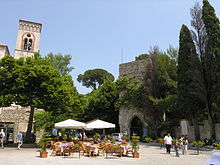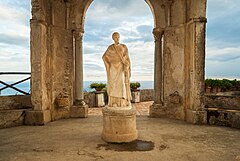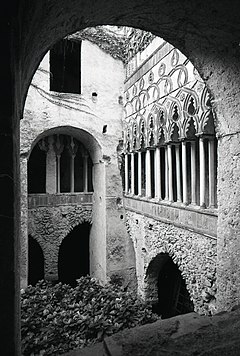You can help expand this article with text translated from the corresponding article in Italian. (January 2022) Click for important translation instructions.
|
| Ravello | |
|---|---|
| Comune | |
| Comune di Ravello | |
 Amalfi Coast looking south from Ravello Amalfi Coast looking south from Ravello | |
 Coat of arms Coat of arms | |
| Location of Ravello | |
  | |
| Coordinates: 40°39′N 14°37′E / 40.650°N 14.617°E / 40.650; 14.617 | |
| Country | Italy |
| Region | Campania |
| Province | Salerno (SA) |
| Frazioni | Sambuco, Torello, Castiglione, Marmorata, San Cosma, San Pietro alla Costa, Monte, Casa Bianca |
| Government | |
| • Mayor | Paolo Vuilleumier |
| Area | |
| • Total | 7.94 km (3.07 sq mi) |
| Elevation | 350 m (1,150 ft) |
| Population | |
| • Total | 2,500 |
| • Density | 310/km (820/sq mi) |
| Demonym | Ravellesi |
| Time zone | UTC+1 (CET) |
| • Summer (DST) | UTC+2 (CEST) |
| Postal code | 84010 |
| Dialing code | 089 |
| Patron saint | St. Pantaleon |
| Saint day | July 27 |
| Website | Official website |
Ravello (Campanian: Raviello, Reviello) is a comune (municipality) situated above the Amalfi Coast, in the province of Salerno, Campania, with approximately 2,500 inhabitants. Its scenic location makes it a popular tourist destination, and earned it a listing as a UNESCO World Heritage Site in 1997.
History
| This section needs additional citations for verification. Please help improve this article by adding citations to reliable sources in this section. Unsourced material may be challenged and removed. Find sources: "Ravello" – news · newspapers · books · scholar · JSTOR (August 2020) (Learn how and when to remove this message) |

Ravello was founded in the 5th century as a shelter place against the barbarian invasions which marked the end of the Western Roman Empire.
In the 9th century Ravello was an important town of the maritime Republic of Amalfi.
It was a producer of wool from its surrounding country that was dyed in the town and an important trading power in the Mediterranean between 839 and around 1200.
In 1086, at the request of the Italo-Norman count Roger Borsa, who wished to create a counterweight to the powerful Duchy of Amalfi, Pope Victor III made Ravello the seat of a diocese immediately subject to the Holy See, with territory split off from that of the archdiocese of Amalfi. Early on, the bishops of Ravello all came from patrician families of the city, showing the church's municipalized character.
In the 12th century, Ravello had some 25,000 inhabitants, and it retains a number of palazzi of the mercantile nobility, the Rufolo, d'Aflitto, Confalone, and Della Marra.
In 1137, after a first failed attack two years before, the Duchy was destroyed by the Republic of Pisa. After this, a demographic and economic decline set in, and much of its population moved to Naples and its surroundings in the Kingdom of Naples.
In 1944 during WW2, the king of Italy lived in Ravello—at the "Palazzo Priscopio"—while waiting to go back to Rome



Main sights
| This section is written like a travel guide. Please help improve the section by introducing an encyclopedic style or move the content to Wikivoyage. (January 2022) |
- The Duomo di Ravello [it] (Cathedral of Ravello): the central nave contains the "Pulpit of the Gospels", on the right of the central nave, created in 1272 by Nicolò di Bartolomeo from Foggia.
- Villa Rufolo (1270), built by Nicola Rufolo, one of the richest Patricians of Ravello, on a ledge and it has become a famous attraction for thousands of visitors. The villa was mentioned by Giovanni Boccaccio in his Decameron and it is the place where Richard Wagner in 1880 was inspired for the stage design of his opera Parsifal.
- Villa Cimbrone, known for its "Terrace of the Infinite".
- The church of San Giovanni del Toro (named for John the Apostle and for "Il Toro", the former name of the old aristocratic quarter in which it was built) dating to before the year 1000. The church contains the Bove pulpit, dateable to 1200–1230, incorporated as mosaic fragments Raqqa bacini.
- The small church of Santa Maria a Gradillo (11th century). It has a basilica plan, with an apse and two aisles.
- Sanctuary of Sts. Cosmas and Damian (14th century)
- La Rondinaia (The Swallow's Nest), built in the 1930s on a cliff face, the villa was the Italian residence of Gore Vidal until 2004.
Culture
The town has served historically as a destination for artists, musicians, and writers, including Giovanni Boccaccio, Richard Wagner, Edvard Grieg, M. C. Escher, Virginia Woolf, Greta Garbo, Gore Vidal, André Gide, Joan Miró, Truman Capote, Tennessee Williams, Graham Greene, Jacqueline Kennedy, Leonard Bernstein and Sara Teasdale (who mentioned it in her prefatory dedication in Love Songs).
Every year in the summer months, the "Ravello Festival" takes place. It began in 1953 in honour of Richard Wagner.
The 1953 film Beat the Devil, directed by John Huston and starring Humphrey Bogart, Jennifer Jones, and Gina Lollobrigida in her English language debut, was shot in Ravello. An extended scene of Bogart and Jones romancing was filmed on the Terrazza dell'lnfinito at the Villa Cimbrone.
Transportation
Ravello can be reached from the 163 Amalfitana State Road by private car. The town centre is also served by the 511006 bus.
See also
References
- "Superficie di Comuni Province e Regioni italiane al 9 ottobre 2011". Italian National Institute of Statistics. Retrieved 16 March 2019.
- "Ravello". Tuttitalia (in Italian).
- "Popolazione Residente al 1° Gennaio 2018". Italian National Institute of Statistics. Retrieved 16 March 2019.
- king of Italy at Ravello, www.ilvescovado.it Archived 2020-11-25 at the Wayback Machine
- Duomo di Ravello
- Villa Rufolo
- Villa Cimbrone
- David, Mark (2015-11-03). "For Sale: Gore Vidal's Italian Cliffhanger (EXCLUSIVE)". Variety. Retrieved 2020-10-04.
- Emmer, Michele (2004). Matematica E Cultura 2004. Springer. p. 248. ISBN 978-88-470-0291-3.
- "Beat the Devil (1953) - IMDb". Archived from the original on 2014-10-14.
External links
- Official website (in Italian)
- Ravello Tourism Board
- Ravello Travel Guide about Ravello, Italy
- Ravello Concert Society Official website of the Chamber Music Festival.
- Ravello Festival official website
| Amalfi Coast and Sorrentine Peninsula | ||||||
|---|---|---|---|---|---|---|
| Amalfi Coast |
| |||||
| Sorrentine Peninsula | ||||||